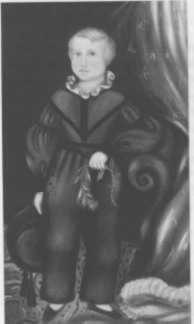
The skeleton suit was a fashion staple for boys. It came in one and two piece styles with numerous buttons in necesary places. It was worn during the French Empire period and the British Regency era Skeleton suits were widely worn by boys througout Western Europe and America. Well dressed boys wore skeleton suits in the last decade of the 18th Century and the early decades of the 19th Century. The style was most populare from about 1790 into the 1830s,
although it was still seen as late as the 1850s. Precursors to the skeleton suits appeared even earlier during the 1770s--but entailed knee breeches rather than long pantaloons. The skeleton suit was one of the first specialized
styles worn by children as opposed to scaled down version of the styles worn by one's fathers. The skeleton suit proved to be one of the more enduring boyhood fashions and was worn by boys and was popular for more than half a century.
The first skeleton suits had some of the features of the classic skeleton suits. I have noticed the higher waisted suits as early as the 1770s, but the style may have originated earlier. These early suits were commonly worn with open ruffled, but not usually lace, collars and front waist buttons. The primary distinguishing feature of the early skeleton suits in the late 18th century were the knee breeches (figure 1). Trousers were not commonly worn until well into the 19th century. Thus the early precursors to the skeleton suit had knee breeches rather than the distintive trousers of 19th century suits. The early skeleton suits appeared to have evolved from the jacket and knee breeches commonly worn by men and boys throughout the 18th Century. The high-waisted pants and one-piece suits for younger boys were the first important specialized boys' fashions. Sailor suits for boys also appeared in the late 18th Century, but until adopted by Queen Victoria in the 1840s were not widely worn by boys. Until the late 18th Century, boys once breeched just wore smaller versions of their fathers clothes. The skeleton suits were specifically for boys. Almost all existing images of skeleton suits are paintings or drawings. As the earliest photographs of any quality date from the 1840s, this was after the period of greatest popularity for skeleton suits. George Romney's (1734-1802) painting of the Clavering Children in 1777 portrays Thomas John and Catherine Mary, children of George Clavering of Greencroft, in Durham provide insights in late-18th century childrens dress (figure 1). The youngsters and their dogs move gently through an undefined landscape. When he painted it, Romney had just returned from a period of study in Rome and the graceful poses of the figures reflect his familiarity with classical sculpture. The attitudes of the children also effectively capture their juvenile state as well as their gender roles as master of animals and nurturer. Thomas John's open ruffled collar is characteristic of the developing style of skeleton suits. Note that his skeleton suit is a one-piece garment, a style popular for younger boys. Thomas John still wears the knee breeches of the 18th century. His sister's dress clearly shows the developing Empire dress fashion.
|
We are not sure when the first first long trouser skeleton suits appeared. We know that the the first of these skeleton suits were done with knee breeches. We are not sure when the first long pants skeleton suits appeared. It should be understood that men of any social standing or affluences wore knee breeches. We do not know who came uom with the idea that boys shioukd wear long oants. Here we iof course are talking about boys from these privlidged classes. These were boys whose fathers woud bever tghaunk f weearing long triusers. The earlies example of long pants we have noted so far is John Willett painted by George Romney about 1790. The first suits were worn bu European royalty or aristocrats, but this may be in part a function that these were the children most likely to have their portraits painted. The 1790 date of course neabs that there were probaly some appearing in he 1780s. Both Thomas John and the Spanish aristocrat painted by Goya about 1790, lack the very high waistline popular in the early decades of the 19th century have not yet appeared. (Notice the sash worn by the Spanish boy.) The Spanish boy does wear the long pants style well before the turn-of-the century. At this time adult aristocrats and wealthy Spanairds would not have considered wearing trousers--they were considered to be for peasants and workers. Thus it is clear that Europeans were increasingly adoptingspecialized fashions for children.

Figure 3.--This American boy in an undated painting wears a skeleton suit with matching jacket and trousers. Notice the puffed sleeves and ruffled collar. |
Skeleton suits had many variations, but the classic suit had several
common fearures which varied only slightly over time. It was most
popular during the first three decades of the 19th Century. The
classic skeleton suit consisted of a tight, short jacket and usually
matching trousers. The trousers of these classic suits could have
extremely high waistlines. In some cases the waistlines of the trousers
could be halfway between the waist and the arm pits.
The skeleton suit declined in popularity after the 1830s, but it
continued to be worn through the 1850s. I'm not sure about the stylistic
details of these suits, but the waistine of the trousers fell to
normal waist levels.
Navigate the Historic Boys' Clothing Tunic pages:
[Return to the Main skeketon suit page]
[Historical trends]
[Stylistic features]
[Skeleton suit styles]
[Garments]
[Skeleton suit accesories]
[Pantalettes]
[Stockings]
Navigate the Boys' Historical Clothing Web Site:
[Introduction]
[Activities]
[Bibliographies]
[Biographies]
[Countries]
[Clothing styles]
[Chronology]
[Countries]
[Contributions]
[Boys' Clothing Home]
